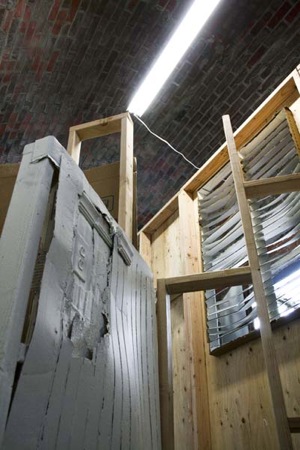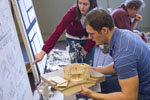Overview of the AAA schools
Ryan Beltram | The School of Architecture & Allied Arts at the University of Oregon is a learning community of teachers and students.
Artist Theresa Sterner profile
Kelli Curtis | Following a Bachelor of Fine Arts student as she readies her installation for a final critique
Architecture student reviews
Topher Vollmer | Instead of spending their time poring through textbooks, architecture students work to prepare for reviews.
Critique Week
A look into the schools of Architecture and Allied Arts
Wet paint, white walls
Theresa Sterner moves from small-scale metalsmithing to large-scale sculpture
by Kelli CurtisTheresa Sterner gazes at the large white expanse of wall in front of her, noticing the wet paint's sheen on her cardboard and wood construction. It's 9:50 a.m., and her installation critique rapidly nears.
T-minus 10 minutes and counting.
----------The old, decrepit brick building by the Mill Race art studios houses her installation, which is 10 weeks' worth of work built up to the coming critiques by fellow bachelor of fine arts students and University of Oregon professors. The building's dust-covered exterior oozes history and years of wear and tear, and a wooden padlocked door on the left opens up to a cramped space. The white cardboard wall, partially covering a white wood wall, stretches up seven feet high and is bolted to side walls two feet from the entry.
Rows of cardboard slats in the cardboard walls reveal a room illuminated by a broken window, showing the smooth texture of a light socket and doorknob moldings in contrast to the unfinished wooden wall frames. The entry to the room is a small space between the white walls and brick, large enough to squeeze through but small enough to make a visitor question whether entry is permissible.
|
 |
"The space for people to squeeze through is meant to be ambiguous so people don't know if they should go through," says Sterner, a BFA with emphasis in sculpture and metalsmithing.
In that first critique of her installation, the layout created a response in the viewers, specifically that cramped space and being pressed up against the aged brick wall in order to look through the shutters to see the next room.
A more subtle impact also grabbed immediate attention: the wet paint. "That wasn't supposed to be that way," she says, laughing, "but that's okay."
In fact, Sterner's decision to paint at all came late in the process. She initially planned on leaving the wood and cardboard bare, but at 9 that morning, one hour before the critique, she pulled out paintbrushes and got to work.
With 10 minutes to go until the critique, Sterner's brushes were put away and she managed to sweep and mop. That's when she noticed an unexpected effect of the paint on her cardboard construct: warping and drooping.
"I build as I go," Sterner says, "and there are always surprising things."
Throughout the term, Sterner largely relied on that "build as you go" philosophy. She spent the first three weeks largely building and casting the moldings every night until 3 or 4 in the morning. She also needed to collect her materials, which included cardboard (free, dug out of recycling and taken from appliance stores), wood bought from Home Depot and rubber meant for molding (her most expensive purchase at $120).
In the last three weeks, the workload intensified, forcing the jeweler-turned-architect to spend "24/7 working," she says.
With her first critique complete as of March 2, Sterner now had to revamp her installation in preparation of another critique. It was originally set for March 9, but she was given the rare opportunity of an extra week to prepare for not only her installation's critique, but also that of her jewelry.
Sterner had a lot to consider in her reworking of her installation; she has professor feedback, but each opinion proves wildly different, leaving her resolved to find a solution that suits her aesthetic and purpose. Specifically, she intends on introducing color to her work by painting the cardboard slats and wall brown, including the doorknob and details. But the most dramatic change Sterner may make is completely rotating and flipping her design.
"I want to see how things relate spatially and with the existing architecture," she says.
"There's a fine line between figuring out how visually realistic and abstract I want to be," Sterner says.
Playing with those dynamics also proved interesting in her transition from jeweler to sculptor and architect. The scale and scope of the two range drastically, but Sterner says her professors think she is merging the two with her precision and fabrication of things.
Sterner, a 23-year-old fifth-year student from Albany, Ore., says her love and early knowledge of jewelry emerged in high school, when she had an art teacher who inspired her.
"And metalsmithing fits my personality," she says. "I'm kind of anal."
After years of working with jewelry, which uses very specific types of materials, Sterner switched to sculpture while attending the University of Oregon. She finds fascination in considering spatial relationships, domestic spaces and entrances in all aspects: doorways, thresholds, hinges and doorknobs.
"Every new installation and trajectory you go on, you have to relearn and line your toolbox with new materials," she says.
Sterner hopes to take her newfound passion for architecture to graduate school. After graduating in June, she plans to spend the next year or two in Portland working before attending a school for sculpture. However, Sterner emphasizes that the school she attends needs to have a strong jewelry and craft commitment. And depending on the programs offered, she may choose interdisciplinary studies to further develop her artistic range.
"I want to go to a big city next," she says, "like Chicago or New York, but I get the feeling it's stuffy and you would have to have connections.
But L.A.'s really interesting in the art world now; it's becoming a new hub."



